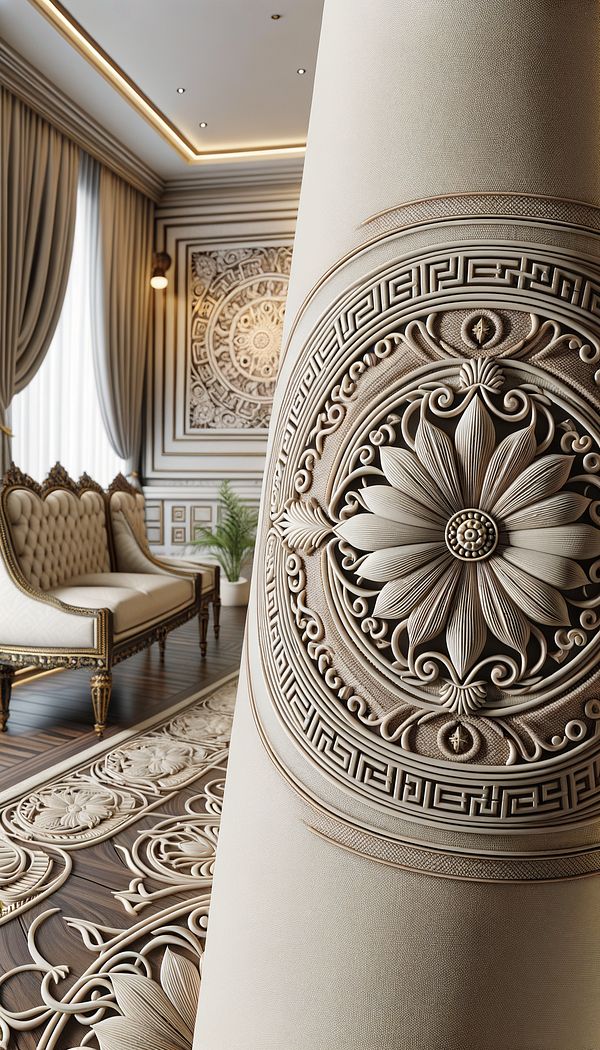What is a Palmette?
Palmette is a decorative motif resembling the fan-shaped leaves of a palm.
Description
The palmette is a distinctive motif that has been widely used in the decorative arts, architecture, and interior design for centuries. Its name, derived from its resemblance to the shape of palm leaves, gives a hint to its natural inspiration. Typically, the palmette consists of a symmetrical fan of foliage, often stylized in a highly decorative manner. It is a versatile motif that has appeared in a myriad of cultures and periods, adapting to fit various artistic and decorative techniques.
This motif has been particularly popular in ancient Greek and Egyptian art, where it was often used to decorate architectural elements, textiles and upholstery, and ceramic wares. In the context of interior design, palmettes can be found in wall and ceiling treatments, furniture types, and even floor coverings and rugs, lending a touch of elegance and historical depth to a space. Their usage ranges from the simple and direct application on surfaces to being an integral part of more complex patterns and designs.
One of the reasons for the palmette's enduring popularity is its ability to blend seamlessly into a variety of design styles. Whether in a classical setting, where it underscores historical continuity and classical elegance, or in more modern spaces, where it adds a layer of sophistication and decorative detail, the palmette motif can add both visual interest and symbolic meaning to interior environments.
Usage
Palmettes are commonly used as a decorative element in classical, neoclassical, and even modern interior designs. They can be found embellishing the tops of columns, friezes, and cornices in architecture. In home decor, they may appear in patterns on wallpaper, fabrics for curtains and upholstery, as well as in the designs of carpets and area rugs. Additionally, palmette motifs are often seen in the details of furniture pieces, such as the carved backs of chairs or decorative panels on cabinets.
FAQs
-
Why is the palmette motif significant in interior design?
The palmette motif is significant in interior design due to its historical depth, versatility, and the elegant and sophisticated touch it can add to spaces. Its presence in a design can communicate a sense of tradition and continuity, while also integrating seamlessly into both classical and contemporary aesthetics.
-
Can the palmette motif be used in modern interiors?
Absolutely. Despite its ancient origins, the palmette motif is incredibly adaptable and can complement modern interiors by adding a layer of decorative detail and sophistication. When used judiciously, it can serve as a bridge between historical references and modern design sensibilities.
-
How is the palmette motif used in furniture design?
In furniture design, the palmette motif is often used as an ornamental detail that enhances the visual appeal of the piece. It can be carved into wood on the backs of chairs, incorporated into the patterns of fabric upholstery, or used in decorative inlays on cabinet doors and tabletops.
Practical Application
To incorporate the palmette motif into interior design, consider its scale and the overall style of the space. In classical or historical-themed interiors, larger, more intricate palmette designs can be used to emphasize the grandeur and elegance of the setting. In contrast, for contemporary spaces, opting for simpler, more stylized palmette patterns will maintain a modern feel while adding a touch of decorative charm. Whether you decide to include the motif in wallpapers, textiles, or furniture, the key is to ensure it harmonizes with the rest of the design elements.
-
Architectural Elements199 articles
-
Design Styles478 articles
-
Furniture Types599 articles
-
Decorative Techniques322 articles
-
Textiles & Upholstery252 articles
-
Italian ProvincialItalian Provincial is a design style that blends refined elegance with a rustic, countryside vibe.
-
Worm HolesWorm holes are small, round holes created by wood-boring insects, often giving wood a distressed, aged appearance.
-
InspirationInspiration in interior design refers to the process or moment when new ideas for designing a space are conceived.
-
LuminanceLuminance is the intensity of light emitted from a surface per unit area.
-
Muted ColorsMuted colors are hues that have been dulled or desaturated.
